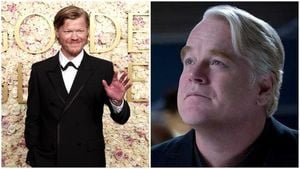It’s hard to picture anyone other than the iconic Al Pacino stepping onto the screen as Michael Corleone nearly 50 years after the release of The Godfather. Yet, as it turns out, the legendary actor wasn't exactly eager to take on the role straight away. According to his recent memoir, Sonny Boy, which just hit bookshelves, he felt more relief than excitement when he twisted his ankle during filming, thinking it might free him from his obligations to the production.
During the shoot, there were considerable rumblings on set about Pacino’s performance. It wasn’t meeting the expectations of Paramount Pictures, leading to rumors circulating about the possibility of him being let go. Coupled with the pressure of director Francis Ford Coppola’s vision for the film, it wasn’t exactly smooth sailing for the young actor at the time. He shared these reflections on the Conan O'Brien Needs A Friend podcast, expressing his emotional state and the burden he felt before the injury. "I had twisted my ankle so badly, I couldn’t move," he recounted. "Everyone on the crew had crowded around me... I lay there thinking, 'This is a miracle. Oh God, you’re saving me. I don’t have to do this picture anymore.'"
Pacino was tasked with performing his own stunts, including a notable scene where Michael Corleone jumps onto a moving car. This was during the climactic moment when his character exacts revenge against Captain McCluskey and Virgil Sollozzo for the assassination attempt on his father, Vito Corleone, played by Marlon Brando. It's during this intense and pivotal filming phase where Pacino faced significant strain, adjusting to the high-stakes demands of making The Godfather.
Despite his hopes of walking away from the film due to the injury, ironically, it was this incident and the scene he had just filmed, showcasing his character's more assertive side, which changed everything. According to him, after the scene where Michael acts decisively for the first time, executives took note of his sincere dedication to the role. "Because of the scene I just performed, they kept me in the film. So I didn’t get fired from The Godfather," he explained.
His injury also led to some unusual, if not amusing, treatments on set. Pacino recalled, "They put one of these big fat needles in my ankle so I could finish the day, and they kept me." This jab helped him to push through the pain and continue his performance, which would eventually lead to his Academy Award nominations for both The Godfather and its sequel.
The backstory to this now-iconic role is riddled with twists of fate. Originally, there wasn't much enthusiasm from Paramount for Pacino to portray Michael Corleone. The studio had its eyes on big-name actors like Jack Nicholson and Warren Beatty, but it was Coppola who pushed for Pacino, believing he embodied the complex layers of the character. Hence, when Pacino was shooting for the role, the stakes were already high, and the pressure immense.
Reflecting on the initial screenplay, Pacino notes, “Mario Puzo had Michael calling himself ‘the sissy of the Corleone family.’” This characterization did not sit well with the image studios wanted to project, which made casting Pacino—a smaller-framed, dark-haired actor—an uphill battle. The physicality of the character on screen is something many now associate with the mafia persona—one surely different from the timid, delicate portrayal Puzo had written.
Undeniably, having Pacino as Michael Corleone changed not just The Godfather, but the course of film history. His portrayal of Michael grew more nuanced as the trilogy progressed, capturing the internal conflict within the character as he transitioned from reluctant participant to ruthless leader. Pacino showcased Michael’s descent and the price of power, making him one of cinema's most tragic figures.
Pacino’s ankle twist and subsequent recovery not only salvaged his career but also paved the way for Hollywood's enduring love for the film and its characters. It reinforced the notion of perseverance, and perhaps, the element of chance often found interwoven within the fabric of filmmaking.
Over the years, The Godfather has become emblematic of classic American cinema. Its narrative, enriched by performances from talented actors like James Caan and Robert Duvall, gives viewers insight not only to the mafia but to the very heart of family loyalty and betrayal.
Looking back, it’s remarkable to think how close the cinematic world came to losing Al Pacino’s performance. Had it not been for the mishap with his ankle, the depths of his portrayal of Michael Corleone might have never seen the light of day. Now, as Pacino reflects on the experience, he is grateful for the serendipitous turn of events, as his involuntary accident transformed not just his career but the legacy of one of the film's greatest characters.
Pacino’s relationship with Michael Corleone, solidified by this near-exit from the film, speaks volumes about challenges actors face during production. It’s not uncommon for performers, especially those breaking through, to battle personal and professional crises on set, making their craft all the more human and relatable. His story serves as both inspiration and reminder of the unpredictability of life and the bizarre twists of fate, sometimes delivering the very experiences we need, even when they come cloaked as setbacks.
Reflecting on his time spent portraying Michael Corleone, Al Pacino can undoubtedly appreciate the irony woven through his experience on The Godfather. What began as potential departure transformed through tenacity and unexpected outcomes lead to artistic glory and lasting reverence—demonstrated through the accolades and appreciation secured over decades.



